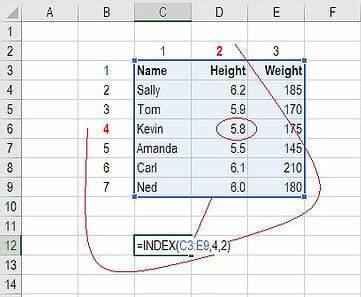
Next, we need to tell MATCH where to look for the lookup value. I have entered the text “Caffe Mocha” in cell A12 and referenced the cell in the formula. In this example, we are looking for “Caffe Mocha” in column A. In the first argument, we tell MATCH what we are looking for.
#Excel indexof how to
Here are instructions on how to write the MATCH formula. In this case, we want to use the MATCH function to return the row number for “Caffe Mocha” from the list of items in column A. We'll use my Starbucks menu example to learn MATCH. Let's dive into an example to see how MATCH works. =MATCH(lookup_value, lookup_array, ) =VLOOKUP(lookup_value, table_array, col_index_number, ) Therefore, we don't need the column index number argument that VLOOKUP requires. MATCH's lookup_array argument is a single row/column. The MATCH function's arguments are also similar to VLOOKUP's.


This simple definition just makes it easier for me to remember the three arguments. The following image shows the Excel definition of the MATCH function, and then my simple definition. The difference is that it returns a row or column number, NOT the value of a cell. Its job is to look through a range of cells and find a match. The MATCH function is really like VLOOKUP's twin sister (or brother). Finally, we will combine the two in one formula. To understand how the formula works, we'll start from the inside and learn the MATCH function first. This can look complex and overwhelming when you first see it! Wrapping Your Head Around INDEX MATCHĪn INDEX MATCH formula uses both the INDEX and MATCH functions. With INDEX MATCH there's less maintenance required for your formulas when changes are made to your worksheet. The calculation can also slow down if there are other formulas or dependencies in the table array. Why is this a benefit? Because VLOOKUP formulas tend to break when columns in a table array get inserted or deleted. #2 – Separate Lookup and Return ColumnsĪnother benefit is that you specify a single column for both the lookup and return ranges, instead of the entire table array that VLOOKUP requires. Yes, you can technically use the CHOOSE function with VLOOKUP to lookup to the left, but I wouldn't recommend it (performance test). With VLOOKUP you're stuck returning a value from a column to the right. The first advantage of using these functions is that INDEX MATCH allows you to return a value in a column to the left. There are two main advantages that INDEX MATCH have over VLOOKUP.

It's best to first understand why we might want to learn this new formula. INDEX MATCH Formulas Explained.xlsx (268.6 KB) Advantages of Using INDEX MATCH instead of VLOOKUP I encourage you to follow along and practice writing the formulas. Here is the Excel file that I used in the video.


 0 kommentar(er)
0 kommentar(er)
